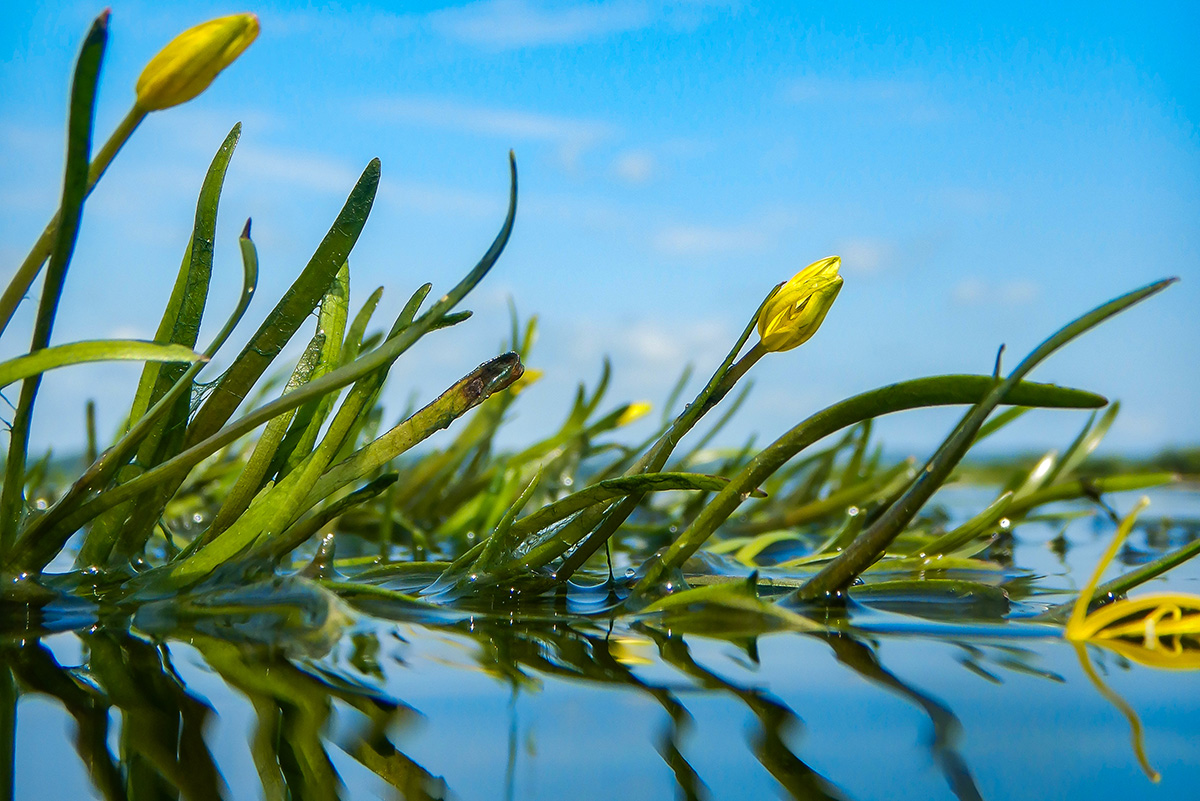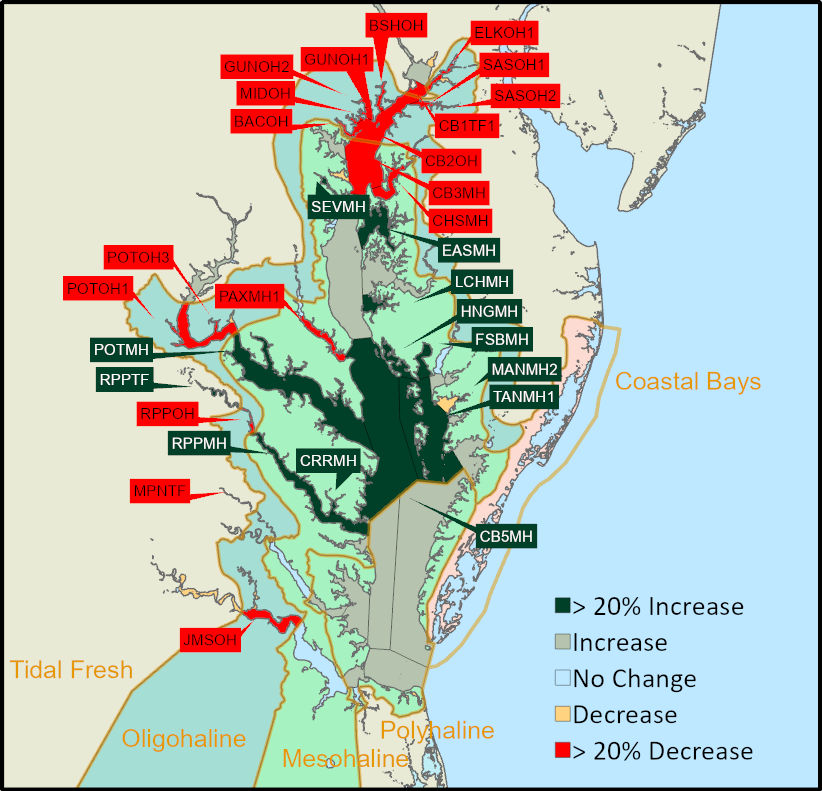Experts encouraged by continued expansion of Chesapeake Bay grasses
High salinity regions showed record expansion of eelgrass
 Underwater grasses in the Chesapeake Bay expanded 7% to an estimated 82,937 acres in 2023 to reach their seventh-highest level in 40 years of monitoring, according to an annual survey led by researchers at William & Mary’s Virginia Institute of Marine Science (VIMS) in collaboration with the Maryland Department of Natural Resources.
Underwater grasses in the Chesapeake Bay expanded 7% to an estimated 82,937 acres in 2023 to reach their seventh-highest level in 40 years of monitoring, according to an annual survey led by researchers at William & Mary’s Virginia Institute of Marine Science (VIMS) in collaboration with the Maryland Department of Natural Resources.
Submerged aquatic vegetation (SAV) provides critical habitat for many of the Bay’s most coveted species. And because they require clear water to obtain sunlight, SAV serves as an important bellwether for the overall health of the Chesapeake Bay.
“Overall, the 2023 numbers are encouraging and nearly back to levels observed before the dramatic declines we experienced in 2019,” said Associate Professor Christopher Patrick, who directs the SAV Monitoring and Restoration Program at VIMS and is a member of the Chesapeake Bay Program’s SAV Workgroup. “While we had some localized declines, we had impressive gains in areas of great ecological importance. We also observed grass beds in depths up to nine feet at low tide in some areas, which was surprising to many and an indicator of good water clarity.”
Researchers divide the bay into four regions based on the salinity of the water:
- Tidal fresh: This region of the bay is comprised of freshwater still influenced by tides. Here grass beds increased 3% to 19,804 acres.
- Oligohaline: This slightly salty region saw a 54% decrease, bringing the total acreage to 3,429 in 2023 compared to 7,145 in 2022.
- Mesohaline: This moderately salty zone is the largest of the four regions. It saw a substantial increase of 21% to 37,961 acres.
- Polyhaline: This very salty region showed an increase of 12% to 21,743 acres.
The losses in the oligohaline region were mostly localized to the Middle River and Gunpowder River, which also saw declines in 2022. Last year, researchers noted an increase in turbidity in this area, suggesting the cause may be affiliated with events happening within the rivers’ watersheds.
“While we’re trying to pinpoint the reasons for the declines in the oligohaline area, it’s important to note that this is a relatively small region. This means that declines in this area significantly impact the regional numbers, but it does not have a huge impact on the total counts for the Bay,” said Patrick.
Of note, the polyhaline region showed the largest amount of SAV since 1997, growing at depths in some places not seen in decades. This is encouraging, as the region provides important habitat for many species and is predominately occupied by eelgrass (Zostera marina), which has been overtaken by widgeon grass (Ruppia maritima) as the dominant grass species in the Bay. There are 17 different species of SAV in the Chesapeake Bay.

Conducting the survey
VIMS has tracked the abundance of underwater grasses as an indicator of Bay health since 1978, with the annual survey launched in 1983. The efforts were started by former Professor Robert J. Orth, conducted using aerial photographs taken from planes following specific flight patterns. In recent years, satellite imagery has been used to supplement aerial photographs when weather or other factors prohibit flights or adequate photos.
“The survey is a tremendous undertaking and requires ideal conditions of low winds, low tide and clear skies in order to properly photograph the grass beds,” said Patrick. Ground surveys help supplement and confirm the presence of grass beds found in aerial surveys. More information on the survey methods is available on the VIMS website.
The survey allows the Chesapeake Bay Program to assess progress toward restoration goals outlined in the Chesapeake Bay Watershed Agreement, which set a target of restoring 130,000 acres by 2025. The 2023 numbers represent a 61% achievement of that goal and a 45% attainment of the ultimate goal of 185,000 acres of restored grasses. At its most pristine condition, it’s believed the Chesapeake Bay could have supported up to 600,000 acres of SAV.
Managing water quality key to future success
Underwater grasses are very sensitive to environmental conditions. Historically, the Chesapeake Bay was dominated by eelgrass. However, decades of water quality and habitat degradation combined with the effects of Tropical Storm Agnes in 1972 led to widespread declines. Eelgrass recovery in subsequent decades was halted by increasing summer temperatures and more frequent marine heatwaves.
A VIMS-led study published in Proceedings of the National Academy of Science in May 2023 documented the rise of widgeon grass in areas once dominated by eelgrass. Widgeon grass is more heat tolerant than eelgrass and its seeds are longer lasting. However, widgeon grass is very sensitive to increased nutrient levels, which can lead to drastic fluctuations in coverage. Widespread declines documented in 2019 were attributed to increased run-off entering the Bay following a very wet spring season.
“The losses observed in 2019 wiped out nearly a decade of progress, but we have rebounded well in the last three years,” said Patrick. “We are also seeing very encouraging expansion of eelgrass in the lower portion of the Bay, with the highest numbers ever recorded in Mobjack Bay.”
Patrick and other experts attribute the expansion of eelgrass in the saltier regions of the lower Bay to relatively warm winters and fewer documented marine heatwaves, possibly in relation to the La Niña climate cycle. However, with summer temperatures trending ever higher, VIMS experts predict that eelgrass may struggle in the future.
“Nutrient reductions throughout the Chesapeake Bay’s watershed have played a critical role in SAV recovery,” said Patrick. “With the rise of widgeon grass as the dominant species, we must continue to focus on ways to maintain and improve water quality if we hope to continue progress on SAV restoration and combat the effects of human population growth and climate change.”
More information about the SAV Monitoring and Restoration Program can be found on the VIMS website.
